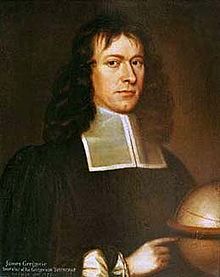James Gregory (mathematician): Difference between revisions
m Robot: Editing intentional link to disambiguation page in hatnote |
add family details |
||
| Line 39: | Line 39: | ||
He was successively [[professor]] at the [[University of St Andrews]] and the [[University of Edinburgh]]. |
He was successively [[professor]] at the [[University of St Andrews]] and the [[University of Edinburgh]]. |
||
He had married Mary, daughter of George Jameson, painter, and widow of Peter Burnet of Elrick, Aberdeen; their son James was Professor of Physic at King's College Aberdeen. He was the grandfather of [[John Gregory]] (FRS 1756); uncle of [[David Gregorie]] (FRS 1692) and brother of David Gregory (1627-1720), an inventor. <ref> http://www2.royalsociety.org/DServe/dserve.exe?dsqIni=Dserve.ini&dsqApp=Archive&dsqCmd=Show.tcl&dsqDb=Persons&dsqPos=0&dsqSearch=%28Surname%3D%27gregory%27%29 </ref? |
|||
He died at [[Edinburgh]]. |
He died at [[Edinburgh]]. |
||
Revision as of 20:00, 26 June 2010
James Gregory | |
|---|---|
 James Gregory (1638–1675) | |
| Born | 1638 |
| Died | 1675 |
| Nationality | Scottish |
| Citizenship | Scotland |
| Alma mater | Marischal College (University of Aberdeen), University of Padua |
| Known for | Gregorian telescope Diffraction grating, Calculus |
| Scientific career | |
| Fields | Mathematics Astronomy |
| Institutions | University of St. Andrews, University of Edinburgh |
| Notes | |
Nephew of Alexander Anderson. Uncle of David Gregory. | |
James Gregory FRS (November 1638 – October 1675) was a Scottish mathematician and astronomer. He described the first practical reflecting telescope - the Gregorian telescope - and made advances in trigonometry, discovering infinite series representations for several trigonometry functions.
Biography
The youngest of the 3 children of John Gregory, an Episcopalian Church of Scotland minister, James was born in the manse at Drumoak, Aberdeenshire, and was initially educated at home by his mother, Janet Anderson. It was his mother who endowed Gregory with his appetite for geometry, her brother - Alexander Anderson - having been a pupil and editor of Viète. After his father's death in 1651 his elder brother David took over responsibility for his education. He was sent to Aberdeen Grammar School, and then to Marischal College, graduating in 1657.
In 1663 he went to London, meeting John Collins and fellow Scot Robert Moray, the first President of the Royal Society. In 1664 he departed for the University of Padua, in the Venetian Republic, passing through Flanders, Paris and Rome on his way. At Padua he lived in the house of his countryman James Caddenhead, the professor of philosophy, and he was taught by Stefano Angeli.
Upon his return to London in 1668 he was elected a member of the Royal Society, before travelling to St Andrews in late 1668 to take up his post as the first Regius Chair of Mathematics, a position created for him by Charles II, probably upon the request of Robert Moray.
He was successively professor at the University of St Andrews and the University of Edinburgh.
He had married Mary, daughter of George Jameson, painter, and widow of Peter Burnet of Elrick, Aberdeen; their son James was Professor of Physic at King's College Aberdeen. He was the grandfather of John Gregory (FRS 1756); uncle of David Gregorie (FRS 1692) and brother of David Gregory (1627-1720), an inventor. Cite error: A <ref> tag is missing the closing </ref> (see the help page)..
The telescope design attracted the attention of several people in the scientific establishment such as Robert Hooke, the Oxford physicist who eventually built the telescope 10 years later, and Sir Robert Moray, polymath and founding member of the Royal Society.
The Gregorian telescope design is rarely used today, as other types of reflecting telescopes are known to be more efficient for standard applications. Gregorian optics are also used in radio telescopes such as Arecibo, which features a "Gregorian dome".[1]
Other work
In 1671, or perhaps earlier, he rediscovered the theorem that 14th century Indian mathematician Madhava of Sangamagrama had originally discovered, the arctangent series
for θ between −π/4 and π/4. This formula was used by Madhava to calculate digits of π and later used in Europe for the same purpose, although more efficient formulas were later discovered.
James Gregory discovered the diffraction grating by passing sunlight through a bird feather and observing the diffraction pattern produced.[2] In particular he observed the splitting of sunlight into its component colours – this occurred a year after Newton had done the same with a prism and the phenomenon was still highly controversial.
Gregory, an enthusiastic supporter of Newton, later had much friendly correspondence with him and incorporated his ideas into his own teaching, ideas which at that time were controversial and considered quite revolutionary.
The crater Gregory on the Moon is named after him. He was the uncle of mathematician David Gregory.
See also
References
- ^ "Jim Cordes Big Dish". Retrieved 2007-11-22.
- ^ Letter from James Gregory to John Collins, dated 13 May 1673. Reprinted in: Correspondence of Scientific Men of the Seventeenth Century...., ed. Stephen Jordan Rigaud (Oxford, England: Oxford University Press, 1841), vol. 2, pages 251-255; see especially page 254. Available on-line at: Books.Google.com.
Further reading
- Turnbull, H. W. (1940–1941). "Early Scottish Relations with the Royal Society: I. James Gregory, F.R.S. (1638–1675)". Notes and Records of the Royal Society of London. 3: 22–38. doi:10.1098/rsnr.1940.0003.
{{cite journal}}: Check date values in:|year=(help)
- J J O'Connor and E F Robertson. ""Biography of James Gregory"". University of St Andrews School of Mathematics and Statistics. Retrieved 2009-05-04.
External links
- Tunrbull, H. W. (1938). "The Tercentenary of the birth of James Gregory". Retrieved 2008-10-19.
- O'Connor, John J.; Robertson, Edmund F., "James Gregory", MacTutor History of Mathematics Archive, University of St Andrews
- Trinity College Dublin History of Mathematics
- James Gregory's Euclidean Proof of the Fundamental Theorem of Calculus at Convergence
- James Gregory Public Lectures on Religion and Science, University of St Andrews

